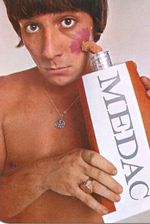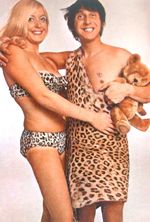
“Are you a mod or a rocker?” the reporters asked Ringo. “No,” he always said. “I’m a Mocker.”
Once upon a time, the Who were Mockers, too.
Their third album, “The Who Sell Out,” is a blast, full of fun and fire, with no fewer than a half dozen killer songs. A vocal minority of critics and fans consider the 1967 album the band’s best.
The space between Who songs goes to a running spoof of pop radio and advertising. There are pirate radio PSAs (“Go to the church of your choice”) and a series of goofy adverts: some by Pete Townshend, and some cooked up in a pub by Keith Moon and John Entwistle.
The concept album — using the term loosely but correctly — also served as a farewell to the Orrible Who’s youth, with its balls-to-the-wall pop singles. After “Sell Out,” it was time for Townshend and company to attend to the serious business of becoming art rockers.
Listen. You can hear the change right there, captured in amber, at the end of side 2. That embryonic riffing in “Rael” sounds familiar because it leads the band straight to the rock opera “Tommy” (listen for “Underture” and “Sparks”).
The critic Dave Marsh, who wrote the definitive study of “The Who Sell Out” for Mojo magazine, points out that side 1 broadcasts on AM, and side 2 on FM (a cultural quantum leap).
Marsh considers “The Who Sell Out” the best rock album of the 1960s. If the usual suspects “Pet Sounds,” “Revolver” and “Sgt. Pepper” are to be considered out of historical context, Marsh’s position isn’t as far out as it might seem.
“The Who Sell Out” isn’t much of a psychedelic album, though. (If it were, it’d be much higher on this list.) “Sell Out” does reflect what was what in 1967 — the heady year of its making — but more importantly it drops two remarkable psychedelic rock songs: the thunderous single “I Can See for Miles” and the album-opening sci-fi adventure “Armenia City in the Sky.”
In fact, the band was busy trying to sell out, making commercials for Coca-Cola. John Entwistle used “Sell Out” to hawk his new bass strings. Some people know the album only for its cover images of faux endorsements — Roger Daltrey in a tub of Heinz beans; Pete Townshend applying Odorono to his ‘pits; Keith Moon slathering on pimple cream; John Entwistle getting the blonde with the help of Charles Atlas.
At the same time “The Who Sell Out” skewered the squares, Townshend was busy trying to de-pants the music business, which was selling flower power at a torrid pace. The Who’s leader sneered at “the post-psychedelic wetness” — “You could write a song that went, Weee love you, weeeee love you, and it would get to Number 4 in the charts,” Townshend told Mojo decades later (taking a slap at the Stones, most likely).
“I suppose what I wanted was to rescue the pop song,” Townshend recalled. Bingo. “I Can See for Miles” ranks among the greatest of singles, psychedelic or otherwise.
If you lived in the right city, the song was omnipresent in the fall of 1967 (thanks, WQAM). It blew minds while ripping AM radio a new one. Part of its ragged beauty was the shape-shifting: You wanted a sing-along pop song, you got it. You wanted to freak out, well, brother, “I Can See for Miles” had that on offer, too.
Townshend felt he never got due credit for the rough-and-ready classic, probably because every hipster on the planet was busy fawning over Jimi Hendrix. The Who were old news in 1967, but not for long.
The influence of Townshend’s local heroes of the moment — Hendrix and Syd Barrett — can be heard on “I Can See for Miles” and here and there on the album. By design or osmosis, Townshend, Moon and Entwistle slip into a few dead-on imitations of the Hendrix Experience. Then there’s this sonic mystery: Listen to the opening seconds of Pink Floyd’s “Interstellar Overdrive” — sound familiar? Who came first?
“I Can See for Miles” is an exercise in tension and release. Make that Dynamic Tension and release. Moon’s drums start out fidgety, uncharacteristically in check, before exploding like Howitzers in a hall closet. He works the snare like some marching band drummer on meth. The rolls keep things taught and uneasy. Townshend’s massive guitar claws at the song structure, but stays in bounds (it’s an AM radio song, after all). The extended finale’s dizzy-swirling chorus leads into infinity.
The “I Can See for Miles” lyrics certainly have psychedelic cred. They are a warning from our hero (Daltrey) to a frenemy lover. The sorcerer slash stalker witnesses his woman’s betrayals via magical powers of sight. As he explains to her:
The Eiffel Tower and the Taj Mahal are mine to see on clear days
You thought that I would need a crystal ball to see right through the haze
Album opener “Armenia, City in the Sky” sets the mystical tone. We’re transported to a sci-fi world in which “the sky is glass, the sea is brown, and everyone is upside-down.” (The song was written for the band by Townshend’s pal “Speedy” Keen, later of Thundercap Newman.)
Daltrey’s ethereal vocals are rooted by the great plodding bass work of Entwistle. Townshend dive-bombs this fantasy city, his guitar awash in feedback, phase-shifts and backward loops — all the studio-effects obsessions of the day.
But suddenly, reality. Listeners are transported to jingly “Wonderful Radio London.” Commerce calls. Time to sell some Heinz Baked Beans.
The Who never made another album like “The Who Sell Out.” Petra Haden did. In 2005, she recorded “The Who Sell Out” in its entirety, singing all parts, including the instruments.
The a cappella version thrilled Townshend.
“I felt like I’d received something better than a Grammy,” he said.
A deluxe box set of “The Who Sell Out” was set for release in April 2021. It contains seven discs, along with a swarm of bonus tracks, some unreleased and some familiar. … Universal released a long-awaited collectors edition in 1995, with notable bonus tracks “Early Morning Cold Taxi,” “Jaguar” and “Hall of the Mountain King.” In 2009, the album became part of the Deluxe Edition series, with significant upgrades including the mono mix (unheard in decades) and a huge helping of bonus tracks and studio nonsense.


Great read. It’ll always be psych to me though.
Wot’s For Dinner, Mum?
A quirky album with some belter tunes on it. Love it!
Immensely underrated and excellent LP
My favorite.
Fantastic take on 60s BBC radio or their own Pirate radio off the coast! Love the deluxe edition with some of Pete’s best little pop songs!
Great album. My favorite Who album.
I should have used *Odorono.
More music, more music, more music …
Love this album. Warhol set to music.